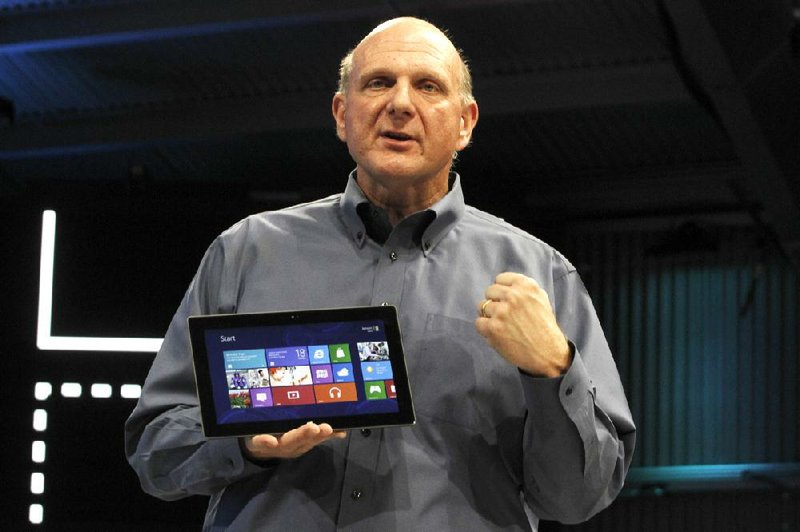LITTLE ROCK — Microsoft’s lumbering crawl into mobile technology had many writing off the titan of computer software as a has-been.
But after unveiling its first tablet, called the Surface, some analysts advise not to count the company out.
Several years behind its Silicon Valley rivals, Microsoft is betting it can play catch-up on tablets and smart phones by leveraging its dominance in the workplace and its success in the living room.
Just imagine Microsoft offering its Office software exclusively on the Surface while providing access to XBox games and videos.
It could be the right mix of professional and personal elements - a combination that Apple and Google haven’t been able to achieve fully.
Then add the other online assets Microsoft has amassed over the years: the videoconferencing service Skype, the professional social network Yammer and the search engine Bing.
The potential is great, analysts say, if the notoriously bureaucratic tech giant doesn’t repeat its past mistakes.
“Microsoft has had all the pieces for a consumer strategy for years, and they’ve totally and utterly failed time and time again,” said Michael Gartenberg, an analyst at Gartner research.
Standout failures include Microsoft’s Zune music player and the Kin smart phone, which were panned by critics and fed the reputation that Microsoft was out of touch with consumers.
“The trick is if they can tie it all together into a compelling story and get consumers to buy into a whole ecosystem of devices and apps, which is what Apple has done so well and Google has done well, too,” Gartenberg said.
One version of the Surface, which won’t go on sale until sometime in the fall, is 9.3 millimeters thick and works on the Windows RT operating system, which was made for tablets that run on low-power chips designed by British chip maker ARM Holdings PLC.
It comes with a 0.7-millimeter thick kickstand to hold it upright and a 3-millimeterthick touch keyboard cover that snaps on with magnets. The device weighs less than 1.5 pounds.
The size is similar to the latest iPad, which is 9.4 millimeters thick and weighs 1.3 pounds.
Surface’s screen measures 10.6 inches diagonally, compared to 9.7 inches for the iPad, but it comes in the 16:9 aspect ratio, which is suited to watching video in the widescreen format. The iPad’s screen size ratio is 4:3.
The Surface’s price tag, Microsoft said, will be similar to the iPad, which sells for $499 to $829, depending on the model.
A slightly thicker version - still less than 14 millimeters thick and less than 2 pounds- will work on Microsoft’s upcoming Windows 8 Pro operating system and cost as much as an Ultrabook, the company said. The pro version comes with a stylus that allows users to make handwritten notes on documents such as PDF files. It will be released about three months later.
The touch keyboard resembles the lightweight “Smart Cover” that Apple Inc. sells for $38, but comes with a full QWERTY keyboard. It is rigidly flat instead of foldable. A slightly thicker keyboard with depressable keys will also be available.
Microsoft hopes office workers will want the Surface’s keyboard and stylus to produce Excel spreadsheets or PowerPoint presentations and then take the gadget home to watch movies.
Microsoft’s Office suite of apps has a stranglehold on businesses. It’s also gained a foothold in households with its XBox Live, which has 40 million subscribers. The service charges customers a fee to play games online and watch streaming videos through their game console, which has sold 66 million units.
When it announced the Surface in Los Angeles last week, Chief Executive Officer Steve Ballmer said the device will straddle the tablet and PC worlds. The higher-end Surface will run the full version of the new Windows 8 operating system.
“No compromises,” Ballmer said. Microsoft didn’t announce a price or shipment date.
Apple, in contrast, appears to have drawn a brighter line between its tablet and Mac notebook, which for now run different operating systems, analysts said.
Microsoft’s move was prompted by the iPad’s runaway success. Tablet sales are expected to increase 54 percent to 107 million units this year, according to research firm IDC. In 2016, consumers will buy 221 million tablets, IDC said this week.
Tablets are stealing away laptops and computer owners and even beginning to win over some businesses. This year, PC sales are expected to rise just 5 percent to 383 million units, compared with 10 percent growth the previous year.
Microsoft has struggled to keep an entrepreneurial edge given these sea changes in the computing world, experts say.
When Ballmer took over day-to-day operations from Bill Gates in 2000, he tried to thin out a bloated management structure. But engineers and marketing teams often worked in different buildings and traveled by shuttle bus across the vast Redmond, Wash., campus for meetings.
The move to develop its own hardware device also risks alienating key partners who have helped put the Windows software in the vast majority of households and businesses around the world.
“They have very little slack to make this new strategy relevant to everyone,” said Al Hilwa, an analyst at IDC. “Microsoft is trying to give you multiple access points to their ecosystem of content and apps, which is what Apple has done very well and Google is doing, too. It will be a race of giants.” Information for this article was contributed by Cecilia Kang of The Washington Post and by Ryan Nakashima, Michael Liedtke and Peter Svensson of The Associated Press.
Business, Pages 19 on 06/25/2012

